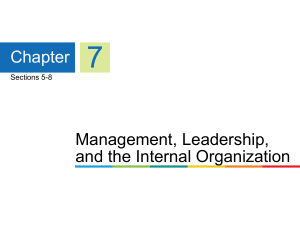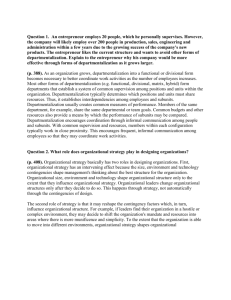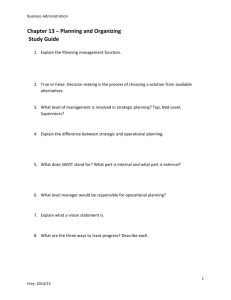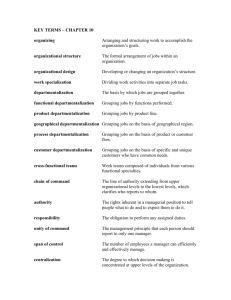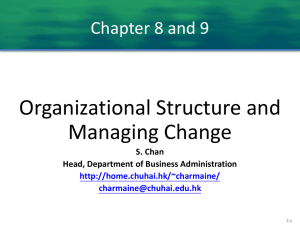Strategic or Operational Planning?
advertisement
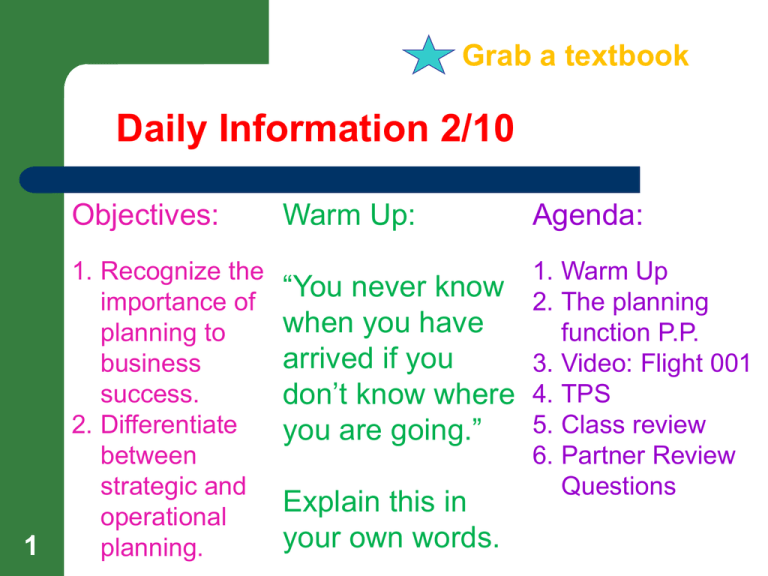
Grab a textbook Daily Information 2/10 1 Objectives: Warm Up: 1. Recognize the importance of planning to business success. 2. Differentiate between strategic and operational planning. 1. Warm Up “You never know 2. The planning when you have function P.P. arrived if you 3. Video: Flight 001 don’t know where 4. TPS 5. Class review you are going.” 6. Partner Review Questions Explain this in your own words. Agenda: Why Plan? 2 Managers that can effectively plan for a business’s future are more likely to be successful than those who concentrate only on day-to-day operations Poor planning can result in losses and business failure What is Planning? Planning is choosing a goal and developing a method or strategy to achieve that goal. Involves: Analyzing the opportunities and risks Most important management activity Guides business decisions Can be like a jigsaw puzzle (must fit together) How To Make a Plan That Works Setting S.M.A.R.T. Goals Specific Measurable Attainable Realistic Timely Flight 001 Video Click picture to play video What plans need to be in place before they can meet their expansion goals? In what ways might the introduction of the Flight 001 brand of products help the business? How did the change in the economy affect Flight 001’s plans for the year? Developing Effective Action Plans An action plan lists… Specific steps (how) People (who) Resources (what) Time period (when) …for accomplishing a goal Tracking Progress Proximal goals – – Distal goals – Short-term or subgoals Enable you to achieve distal goals 1 piece at a time Long-term or primary goals Performance feedback – Regular feedback allows you to track progress toward goals Maintaining Flexibility Options-based planning – keep options open by making, small investments in several alternative plans. Slack resources – a cushion of resources, like extra time or money, that can be used to address and adapt to unanticipated changes. Planning from Top to Bottom Works best when goals and action plans at the bottom and middle of the organization support the goals and action plans at the top of the organization. • Everyone needs to be on the same page!!! Levels of Planning Strategic planning: long-term planning that provides goals and direction (Top-Management) – Operational planning: short-term planning that identifies specific activities for each business area (Lower-Level Management) – – – 11 SWOT analysis How the work will be done Who will do it What resources will be needed to accomplish goals Strategic Planning 12 Figure 13-1: Page 325 of Textbook In your groups, review the figure step-by-step What does each step contribute to effective planning? What might happen to the company’s plans if that step was ignored? – 13 Write down your answers SWOT Analysis Internal – External – 14 Strengths and Weaknesses within the company Opportunities and Threats from its external environment. Factors To Consider 15 Economic conditions facing the business Past sales and profits Demand for products/services Reactions of current/prospective customers Business resources Actions of competitors Planning Tools Budget: specific financial plan Schedule: time plan for reaching objectives Standard: measure against which something is judged Policies: guideline for making decisions in recurring situations Procedures: steps followed for performing certain work or in response to a particular event Vision: statement of a company's purpose or reason for existing 16 Strategic or Operational Planning? 17 A new warehouse will be built to serve the markets in the northeast section of the country Strategic or Operational Planning? A new warehouse will be built to serve the markets in the northeast section of the country Strategic 18 Strategic or Operational Planning? 19 The advertising budget for the next three months will be increase by 2 percent at attract more customers into the store Strategic or Operational Planning? The advertising budget for the next three months will be increase by 2 percent at attract more customers into the store Operational 20 Strategic or Operational Planning? 21 The Cleveland facility will schedule a oneweek shutdown in December to allow for equipment repairs Strategic or Operational Planning? The Cleveland facility will schedule a oneweek shutdown in December to allow for equipment repairs Operational 22 Strategic or Operational Planning? 23 An export office in Rome will be used to develop plans for European market development Strategic or Operational Planning? An export office in Rome will be used to develop plans for European market development Strategic 24 Strategic or Operational Planning? 25 A small business owner has decided to expand into other states by selling franchises Strategic or Operational Planning? A small business owner has decided to expand into other states by selling franchises Strategic 26 Activity CheckPoint – – – 27 Page 324 Page 327 Page 332 13.1 Assessment (Q’s: 1-4) 13.2 Assessment (Q’s: 1-2) Daily Information 2/11 Objectives: 1. Describe factors that managers should consider when organizing work. 2. Describe the advantages and disadvantages of organizational 28 structures. Warm Up: Grab a textbook Agenda: 1. Warm Up 2. Organizing P.P. Do you believe 3. Review you are Questions organized? If so, (partners) describe what you 4. Individual do to keep activity organized. Organizing Work Arranging resources, relationships between departments and employees Define responsibility for everyone involved to complete the task – 29 Example: New Product Departments affected: research, manufacturing, human resources, marketing and sales, finance, information technology Once each department knows what they have to do, work is assigned to the people within each department Organization Charts A drawing that shows the structure of an organization, job classifications, relationships between personnel. Identify lines of authority Shows accountability Show major work areas of a business 30 Organization Chart General Manager VP Purchasing VP Merchandising VP Finance Advertising and Promotion Manager Customer Service Manager Sales Manager Delivery 31 Service and Repairs Characteristics of Good Organization 32 Responsibility: obligation to do an assigned task Authority: right to make decisions about assigned work and make assignments to others Accountability: obligation to accept responsibility for outcomes of assigned tasks Unity of command: principle that no employee reports to more than one supervisor at a time or for a particular task Span of control: number of employees any one manager supervises directly Departmentalization The method of dividing work and workers into separate units that complete particular tasks: Functional Product Customer Geographic Matrix Functional Departmentalization Organizes work by business functions or expertise Advantages – – – work is completed by highly qualified specialists lowers costs by reducing duplication makes communication and coordination easier Disadvantages – – cross-department coordination can be difficult slower decision making Functional Departmentalization Product Departmentalization Organizes work by products or services Advantages – – – allows you to specialize in one area of expertise easier to assess performance faster decision making Disadvantages – – duplication coordination across different product departments Product Departmentalization © 2011 Cengage Learning Customer Departmentalization Organizes work by particular kinds of customers Advantages – – focuses on customer needs allows companies to specialize products and services to customer needs Disadvantages – – duplication of resources (primary disadvantage) workers might please customers but hurt business Customer Departmentalization © 2011 Cengage Learning Geographic Departmentalization Organizes work by geographic area Advantages – – helps companies respond to different markets reduces costs by locating unique resources closer to customers Disadvantages – – duplication of resources difficult to coordinate departments Geographic Departmentalization: Coca-Cola Enterprises Matrix Departmentalization A hybrid structure in which two or more forms of departmentalization are used together: Advantages – – allows companies to manage large, complex tasks gives more diverse set of expertise and experience Disadvantages – – – – requires a high level of duplication violates the principle of unity of command confusion and conflict between project bosses requires much more management skill Matrix Departmentalization: Procter & Gamble Chain of Command Chain of command – the vertical line of authority that clarifies who reports to whom throughout the organization Unity of command – workers should report to just one boss Delegation: Responsibility, Authority, Accountability Delegation of authority: when a manager gives direct authority and responsibility to an employee to complete tasks that a manager is normally responsible. Review Questions: Partners Checkpoint: page 340 Assessment 13.3: Questions 1-4 Review Terms and Concepts (page 348) – Determine the Best Answer (page 349) – Questions: 14, 16, 17 Apply What You Know (page 349 and 350) – 46 Questions: 3, 4, 5, 6, 8, 9, 10, 11, 12 Questions: 19, 20, 22, 23, 24 Group Organizational Chart Now that you have your employee work schedule and a good idea as to where you are headed with your business, create an organizational chart for your business. *****If you have not already done so***** 47

